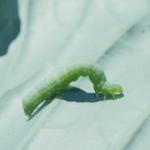Cabbage Looper
Trichoplusia ni
Unlike other Brassica caterpillar pests cabbage looper generally does not become a pest until mid- to late-season. Cabbage looper does not overwinter in New England but arrives in migratory flights from farther south. Generally numbers are not significant until late July or August. Bucket-type pheromone traps can be used to monitor moth flight. Eggs are globe-shaped, light green or yellow, and laid underneath the foliage.
Identification:
Adult moths are mottled gray-brown, 3/4 inch long, with a distinct round silver-white mark on the wing. Caterpillars are light green, with wavy white or light yellow lines down the back and sides, reaching 1 1/2 to 2 inches when full grown.
Cabbage loopers of any size will raise the middle of their body in a characteristic "loop" shape.
Crop Injury:
Feeding damage from older larvae consists of ragged, large holes in foliage, on both frame leaves and heads.
Monitoring & Thresholds:
In the Northeast, there is generally no need to treat young plants unless weather conditions delay plant development and at least 35% of them are infested with any of these pests. Treat plants between the start of heading and harvest if 20% or more of the plants are infested. The most critical time to scout and apply controls is just prior to head formation. Use a 10-15% threshold throughout the season for kale, collards and mustard. Do not use less than 50 gal spray material/A; higher volumes provide better coverage. Better coverage of lower leaf surfaces can be achieved by using drop nozzles. Use a spreader-sticker.
Cultural Controls & Prevention:
- Use selective materials or microbial products, to spare beneficials that help control aphids, DBM and ICW populations.
- Incorporate crop residues shortly after harvest to reduce movement to successive plantings and reduce overwintering populations.
For current information on production methods (including varieties, spacing, seeding, and fertility), weed, disease, and insect management, please visit the New England Vegetable Management Guide website.
Biological Controls:
Populations are suppressed by natural enemies, which include parasitic wasps that attack larvae.
Crops that are affected by this insect:
The Center for Agriculture, Food and the Environment and UMass Extension are equal opportunity providers and employers, United States Department of Agriculture cooperating. Contact your local Extension office for information on disability accommodations. Contact the State Center Director’s Office if you have concerns related to discrimination, 413-545-4800 or see ag.umass.edu/civil-rights-information.

